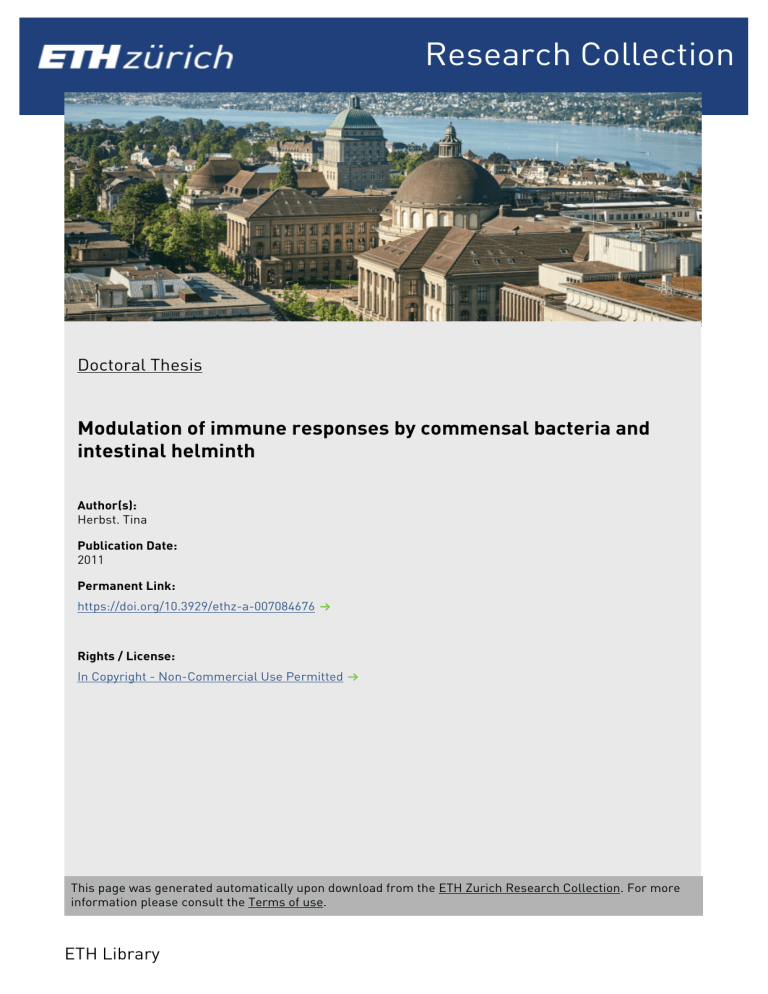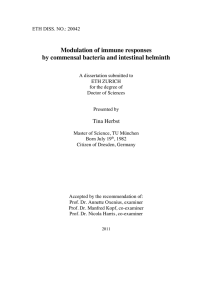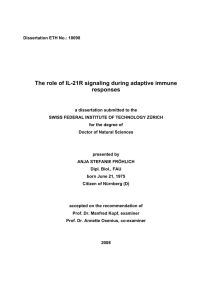Modulation of immune responses by commensal bacteria and
Werbung

Research Collection Doctoral Thesis Modulation of immune responses by commensal bacteria and intestinal helminth Author(s): Herbst. Tina Publication Date: 2011 Permanent Link: https://doi.org/10.3929/ethz-a-007084676 Rights / License: In Copyright - Non-Commercial Use Permitted This page was generated automatically upon download from the ETH Zurich Research Collection. For more information please consult the Terms of use. ETH Library ETH DISS. NO.: 20042 Modulation of immune responses by commensal bacteria and intestinal helminth A dissertation submitted to ETH ZURICH for the degree of Doctor of Sciences Presented by Tina Herbst Master of Science, TU München Born July 19th, 1982 Citizen of Dresden, Germany Accepted by the recommendation of: Prof. Dr. Annette Oxenius, examiner Prof. Dr. Manfred Kopf, co-examiner Prof. Dr. Nicola Harris, co-examiner 2011 Summary The dysregulation of immune responses leads to increasing prevalence of severe human diseases such as autoimmunity, allergy, and cancer and has been linked to microbiota acting to shape the immune status of its host. Two different aspects investigating the immune responses at mucosal surfaces influencing systemic immune conditions are described in this thesis. The first part characterizes the impact of commensal bacteria on the immune response provoked by an allergic airway inflammation. To test how commensals impact on asthma, an animal model of allergic airway inflammation in germ-free (GF) mice was developed and compared to conventionally housed specific pathogen-free (SPF) mice. After systemic sensitization and local airway challenge with ovalbumin, GF mice showed exacerbated eosinophilic and lymphocyte infiltration, elevated levels of the Th2 cytokines IL-4 and IL-5, and increased production of IgE compared to SPF mice. Re-colonization of GF mice with a complex microflora could reverse the increased Th2 phenotype. Regulatory T cells and regulatory cytokines were not changed, instead increased numbers of basophils, heightened numbers and changed phenotype of conventional dendritic cells and a decreased number of alveolar macrophages and plasmacytoid dendritic cells was found. These data demonstrate that the presence of commensal bacteria is critical to ensure normal cellular maturation, recruitment, and control of allergic airway inflammation. The second part elucidates the role of isotype-switched and affinity-matured antibodies on basophils during intestinal helminth infection. It is well appreciated that basophils are potent mediators of Th2 immunity in allergic diseases and helminth IV infections. They act to amplify ongoing Th2 immune responses by the early secretion of cytokines such as IL-4 and release of granule contents like histamine. How they are regulated during these inflammatory processes remained largely unknown. In this thesis, it is shown that basophils originate mainly from the bone marrow and to a lesser extent from the spleen in an IL-3 dependent manner. The expansion of basophils following infection with the intestinal helminth H. polygyrus bakeri was supported by affinity-matured IgG1 and IgE, which induced autocrine IL-3 production. These findings help to understand why basophils are typically associated with Th2 immune responses and imply how antibodies contribute to Th2-mediated immunity. V Zusammenfassung Fehlgeleitete Immunreaktionen führten in den letzten Jahren zu steigender Prävalenz von schwerwiegenden Erkrankungen wie Autoimmunität, Allergien und Krebs. Dies konnte unter anderem mit der Veränderung des Gleichgewichts zwischen Immunmechanismen und der Mikroflora in Verbindung gebracht werden. Diese Dissertation beschäftigt sich mit der Rolle von symbiotischen Bakterien und einem Darmparasiten und deren Wirkung auf den Immunstatus des Wirtsorganismus. Der erste Teil beschreibt die Auswirkungen der kommensalen Bakterien auf die Immunantwort in einem Modell für allergische Entzündungsreaktionen der Atemwege. Um zu testen wie kommensale Bakterien Einflauss auf die Asthmaentwicklung haben, wurde ein Modellsystem für allergisches Asthma bei sterilen (germ-free=GF) und spezifisch Pathogen-freien (SPF) Mäusen entwickelt. Nach systemischer Immunisierung mit Ovalbumin und wiederholter lokaler AntigenApplikation von Ovalbumin wurde bei GF-Mäusen eine verstärkte allergische Reaktion mit vermehrter Infiltration von Eosinophilen und Lymphozyten, sowie erhöhte Konzentrationen der Th2 Zytokine IL-4 und IL-5, als auch gesteigerte IgEProduktion festgestellt. Durch Re-Kolonialisierung der GF-Mäuse mit einer komplexen Mikroflora konnte diese gesteigerte Th2 Immunantwort gemildert werden. Weder regulatorische T-Zellen noch, regulatorische Zytokine, schienen an diesem Prozess massgeblich beteiligt. Hingegen konnten verringerte Mengen von plasmazytoiden dendritischen Zellen und alveolären Makrophagen, sowie erhöhte Zahlen und veränderte Aktivierungsmarker von konventionellen dendritischen Zellen gemessen werden. Unsere Daten zeigen, dass die kommensale Flora einen Einfluss auf die normale Entwicklung von Immunzellen und deren Funktion während einer VI allergischen Asthmareaktion hat. Der zweite Teil beleuchtet die Rolle von Antikörpern, welche einen IsotypenKlassenwechsel und Affinitätsgereiftungen vollzogen haben. Deren Wirkung auf Basophile, während einer Wurminfektion des Darmtrakts, wurde in dieser Dissertation untersucht. Bis heute sind Basophile hauptsächlich für ihre Funktion während allergischen Reaktionen und Parasiteninfetkionen bekannt, bei welchen sie Th2 Immunantworten verstärken. Dieser Effekt wird hauptsächlich auf die Sekretion von IL-4 und Ausschüttung von in Granuolen befindlichen Entzündungsmediatoren zurückgeführt. Wie sie jedoch während dieser Entzündungsreaktionen kontrolliert werden, ist weitgehend unerforscht. In dieser Arbeit wird gezeigt, dass sie von Vorläuferzellen vornehmlich aus dem Knochenmark und zu geringerem Maße auch aus der Milz in Abhängigkeit von IL-3 entstehen können. Der Anstieg von Basophilenzahlen nach Infektion mit dem Darmparasiten H. polygyrus bakeri wurde bedingt durch Antikörper, welche einen Isotypen-Klassenwechsel zu den Klassen IgG1 und IgE sowie eine Affinitätsgereifung vollzogen hatten. Diese führten zu autokriner IL-3 Produktion bei Basophilen. Diese Beobachtungen könnten helfen zu erklären, warum Basophile meist nur in Verbindung mit Th2 Immunantworten gefunden wurden und wie Antikörper zur Entwicklung von Th2 Immunität beitragen. VII


